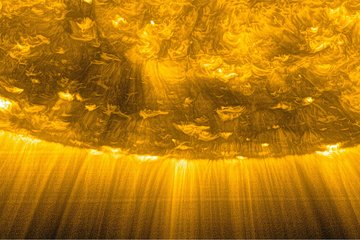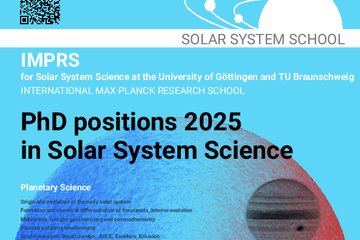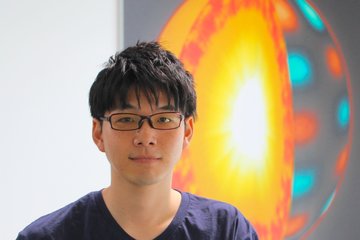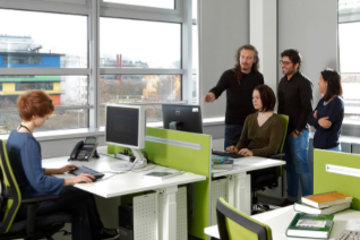Sunrise III: First Look at the Sun
First Light for Sunrise III: the first tests with real sunlight were successful. The balloon-borne solar observatory should be ready for launch at the end of May.
Preparations for this year's stratospheric flight of the balloon-borne solar observatory Sunrise III have reached an important milestone: today, just three weeks after the hardware arrived at Esrange Space Center near the Arctic Circle in Sweden, Sunrise III peered at the Sun for the first time in almost complete flight configuration. During the so-called “First Light”, the team led by the Max Planck Institute for Solar System Research (MPS) successfully showed that the solar telescope, the centerpiece of the observatory, automatically points at the Sun. In addition, the first rays of sunlight offer the opportunity to test and calibrate the scientific instruments and the observatory's image stabilization system with sunlight. All the work was coordinated at the Göttingen Operations Center at the MPS in Göttingen.

Around 10.30 this morning the huge door of the hall affectionately known as the “dome” on the edge of the Esrange Space Center launch field opened. For the first time, sunlight fell into the hall and onto the solar observatory, which was supported by the hall crane and hung freely a few centimeters above the ground directly behind the door. A short time later, the first measurement data from Sunrise III arrived at the Göttingen Operations Center, causing a flurry of activity in Göttingen, some 2500 kilometers away.
“We were extremely lucky with the weather today,” says Dr. Achim Gandorfer, Sunrise III project scientist on site at Esrange Space Center. “The next few days will be cloudy, but everything went well today,” he adds. Having made faster progress than planned in recent weeks, the Sunrise III team was ready to take advantage of the rare sunny day in the otherwise rather hazy northern Swedish spring. In the days before, artificial light sources in the hall had replaced the Sun.
Practicing for the stratospheric flight
“Tests with real sunlight are much more meaningful for our purposes than those with artificial light,” explains MPS scientist Dr. Alex Feller in Göttingen. This is the only way for the scientific instruments to provide data that is similar to that obtained during a flight in the stratosphere, and the only way to test all three instruments at the same time. In addition, the First Light offers the opportunity to test whether the seven-meter-high observatory turns towards the sunlight by itself without external help. This is essential during the flight - and worked smoothly on the ground today. Even the Sun cooperated in today's test: Several smaller sunspots were visible on its surface. “The Sun is currently very active; sunspots are occuring frequently on its visible surface. We therefore hope to be able to observe these areas of high magnetic field strength during the flight”, explains Prof. Dr. Sami Solanki, MPS Director and Sunrise Principal Investigator.
Over the next few weeks, the team members on site in Kiruna and in Göttingen still have a lot to do. The data obtained during First Light will be evaluated, all instruments and systems will be optimized and the exact procedures during the flight will be practiced.
Like the First Light, the launch date itself is also heavily dependent on the weather. Apparently, the stable stratospheric winds that occur in summer and that will carry Sunrise III from Sweden across the Atlantic to Canada, could pick up as early as mid-May. However, calm winds and precipitation-free conditions are also required on the launch day. And to ensure that no nightfall interrupts the solar observations during the flight, the launch can take place at the earliest one month before midsummer, i.e. from around May 25. The stratospheric easterly winds will die down at the beginning of July. “So far, all preparations are going well. We are ahead of schedule and plan to be ready for the first possible launch opportunity that presents itself,” says Dr. Andreas Korpi-Lagg, Sunrise III project manager.
Unique view of the Sun

The upcoming launch is already the second one for Sunrise III. The first flight two years ago had to be terminated a few hours after take-off due to technical difficulties. Its predecessors Sunrise I and II successfully completed their stratospheric flights in 2009 and 2013 and provided unique observational data of the Sun. At an altitude of more than 35 kilometers, Sunrise III, too, will have access to ultraviolet radiation from the Sun and, thanks to its three scientific instruments and image stabilization system, a high-resolution view of the visible solar surface and the processes in the Sun's lower atmosphere.
The balloon-borne solar observatory Sunrise III is a mission of the Max Planck Institute for Solar System Research (MPS, Germany) and the Johns Hopkins Applied Physics Laboratory (APL, USA). Sunrise III looks at the Sun from the stratosphere using a 1-meter telescope, three scientific instruments, and an image stabilization system. Significant contributors to the mission are a Spanish consortium, the National Astronomical Observatory of Japan (NAOJ, Japan), and the Leibniz Institute for Solar Physics (KIS, Germany). The Spanish consortium is led by the Instituto de Astrofísica de Andalucía (IAA, Spain) and includes the Instituto Nacional de Técnica Aeroespacial (INTA), Universitat de València (UV), Universidad Politécnica de Madrid (UPM) and the Instituto de Astrofísica de Canarias (IAC). Other partners include NASA's Wallops Flight Facility Balloon Program Office (WFF-BPO) and the Swedish Space Corporation (SSC).
Sunrise III is supported by funding from the Max Planck Foundation, NASA under Grant #80NSSC18K0934 and #80NSSC24M0024 (“Heliophysics Low Cost Access to Space” program), and the ISAS/JAXA Small Mission-of-Opportunity program and JSPS KAKENHI JP18H05234. The Spanish contributions have been funded by the Spanish MCIN/AEI under projects RTI2018-096886-B-C5, and PID2021-125325OB-C5, and from ”Center of Excellence Severo Ochoa” awards to IAA-CSIC (SEV-2017-0709, CEX2021-001131-S), all co-funded by European REDEF funds, “A way of making Europe”.













